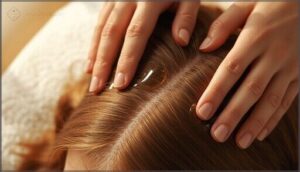This site is supported by our readers. We may earn a commission, at no cost to you, if you purchase through links.
Your scalp produces sebum—its own natural oil—to protect and nourish your hair follicles, but most of us don’t produce quite enough to keep everything running smoothly. That’s where scalp oiling comes in, an ancient practice that’s seeing a major resurgence as people discover its benefits for hair growth and scalp health.
The catch? Too much oil clogs follicles and creates buildup, while too little leaves your scalp parched and irritated. Finding the right frequency isn’t about following a one-size-fits-all rule—it’s about understanding your scalp’s unique needs, from its natural oil production to how it reacts to different climates and stress levels.
The good news is that once you dial in your personal rhythm, you’ll notice healthier hair growth, less irritation, and a scalp that actually feels balanced.
Table Of Contents
- Key Takeaways
- How Often Should You Oil Your Scalp?
- Factors That Influence Scalp Oiling Frequency
- Key Benefits of Regular Scalp Oiling
- Choosing The Best Oil for Your Scalp
- Proper Scalp Oiling Techniques
- Common Mistakes to Avoid When Oiling Your Scalp
- Building a Consistent Scalp Oiling Routine
- Frequently Asked Questions (FAQs)
- Is Oiling Your Scalp Necessary?
- Does Oiling the Scalp Help Hair Grow?
- Is It Okay to Oil Your Scalp Every Day?
- How Often Should I Oil My Scalp for Hair Loss?
- How Long Should I Keep Oil on My Scalp?
- Can I oil my scalp with braids in?
- Should I oil before or after showering?
- Does scalp oiling work for all hair types?
- Can I mix different oils together safely?
- Will oiling my scalp make hair greasy?
- Conclusion
Key Takeaways
- Most people benefit from oiling their scalp once or twice weekly, though your ideal frequency depends on your specific scalp type—dry scalps need 2-3 times weekly, oily scalps only every 10-14 days, and balanced scalps thrive on weekly application.
- Clinical studies show that consistent scalp oiling paired with massage can increase hair growth by nearly 80% and reduce hair fall by over 60% in just eight weeks by stimulating follicles and improving circulation.
- The key to successful scalp oiling isn’t just frequency—it’s using the right oil for your condition (jojoba for dryness, tea tree for dandruff, rosemary for growth), applying 1-2 teaspoons with circular massage motions, and leaving it on for 30-60 minutes before washing thoroughly.
- Common mistakes like over-oiling without proper cleansing, using unsuitable oils for your scalp type, or leaving residue behind can trigger follicle blockage, inflammation, and worsen conditions like dandruff rather than improve scalp health.
How Often Should You Oil Your Scalp?
How often you should oil your scalp isn’t one-size-fits-all—it depends on what your hair and scalp actually need. The good news is that once you understand your specific situation, you can build a routine that works for you.
Let’s walk through the different frequencies that make sense for various hair types and conditions.
General Recommendations for Most Hair Types
Here’s what the evidence tells us: most people benefit from oiling their scalp once or twice weekly. This frequency balances hydration with avoiding buildup—think of it as hitting the sweet spot between nourishment and cleanliness.
Your scalp oiling routine works best when it syncs with your wash schedule. Starting with weekly application gives your scalp health a fighting chance to improve without overwhelming your hair.
You’ll notice real benefits in hair growth, strength, and overall scalp condition when you stay consistent. Understanding the benefits of hair oil treatments is key to developing an effective scalp care routine.
Frequency for Dry, Oily, and Balanced Scalps
Your scalp’s unique profile determines how often you should oil. Here’s what works for different scalp types:
- Dry scalps need oiling 2–3 times weekly to restore moisture and reduce breakage
- Oily scalps benefit from once every 10–14 days to avoid trapping excess sebum
- Balanced scalps thrive on weekly or twice-weekly oiling without buildup
- Dandruff-prone scalps respond well to twice-weekly treatment paired with medicated shampoo
- Textured hair requires more frequent oiling to compensate for reduced natural sebum distribution
Understanding scalp oil benefits is vital for an effective hair care routine.
Match your scalp oiling frequency to your hair type, and you’ll achieve real results.
Adjusting Frequency for Seasonal or Lifestyle Changes
Your scalp health and oil frequency shift with climate variations and environmental factors. During winter, indoor heating cuts scalp hydration by up to 30%, so you’ll need more frequent applications—often 2–3 times weekly.
Summer humidity accelerates sebum production, prompting you to scale back.
Travel considerations matter too: saltwater, chlorine, and altitude changes demand seasonal adjustments to your hair care routine for ideal scalp oiling results.
Factors That Influence Scalp Oiling Frequency
There’s no one-size-fits-all answer to how often you should oil your scalp—it really depends on your unique situation. Your hair’s natural characteristics, the current state of your scalp, and even where you live all play a role in finding the right frequency.
Let’s break down the key factors that’ll help you determine what works best for you.
Hair Type and Texture
Your hair’s unique blueprint determines how often you need to oil. Here’s what shapes your scalp oiling routine:
- Curl patterns: Type 4 coils need oiling 2–3 times weekly, while Type 1 straight hair thrives on once every 1–2 weeks
- Hair porosity: High-porosity strands absorb oil fast but lose moisture quickly, requiring more frequent applications
- Hair density and thickness: Dense or coarse hair needs more coverage, so you’ll oil twice weekly
- Texture analysis: Fine strands get weighed down easily—stick to every 7–14 days
Scalp Condition (Dryness, Oiliness, Dandruff)
Generally, your scalp’s baseline condition reveals everything. Dryness, affecting 39%, requires oiling daily or every other day to restore hair hydration and protect follicles.
Oily scalps, impacting 22% of adults, should be oiled every 10–14 days to maintain scalp pH and oil balance.
Dandruff, a global issue for up to 50%, benefits from targeted scalp oiling twice weekly using antibacterial formulas that address its causes while promoting overall scalp health.
Environmental and Lifestyle Considerations
Constantly, your environment reshapes your scalp’s needs. Urban living increases pollution exposure—cities show 35% more scalp sensitivity—demanding oiling 2–3 times weekly for scalp health. Climate factors matter: low humidity raises water loss by 40%, while sweat management after exercise prevents buildup.
Stress reduction stabilizes oil production, and your hair care routine must adapt. Regular scalp massage during oiling counters environmental damage, supporting ideal hair growth regardless of your lifestyle.
Key Benefits of Regular Scalp Oiling
You already know that scalp oiling takes time and commitment, but what’s actually in it for you? Understanding the real benefits can help you stick with your routine even when life gets busy.
Let’s break down what regular scalp oiling does for your hair and scalp health.
Moisturizing and Hydrating The Scalp
Think of your scalp as soil—when it’s parched, nothing thrives. Scalp oiling directly addresses dryness by restoring the moisture barrier, with research showing barrier-supporting treatments can reduce water loss by nearly 70% over consistent use. Your scalp hydration methods matter:
- Natural moisturizers like coconut and argan oil penetrate quickly
- Oil absorption rates vary by formula weight
- Scalp barrier repair strengthens protective lipid layers
- Hydrating masks intensify moisture delivery
- Regular scalp oiling prevents transepidermal water loss
These hair hydration methods reveal lasting scalp health benefits.
Promoting Hair Growth and Reducing Hair Fall
Want to flip the script on thinning? Clinical evidence shows that scalp oiling can deliver significant scalp health benefits—one ayurvedic study recorded a 79.92% increased hair growth rate and a 63.49% reduction in hair fall after 8 weeks.
Clinical studies show scalp oiling can increase hair growth by nearly 80% and reduce hair fall by over 60% in just eight weeks
Here’s how natural growth boosters and ayurvedic oil remedies accelerate hair regrowth:
| Mechanism | Effect |
|---|---|
| Hair follicle stimulation through scalp massage benefits | Thickness increased from 0.085mm to 0.092mm in 24 weeks |
| Rosemary oil application for hair growth | Comparable efficacy to minoxidil |
| Essential oils + carrier oils for hair loss prevention | Noticeable results within 4-12 weeks |
Regular scalp oiling preps your follicles for transformation.
Soothing Irritation and Preventing Dandruff
Irritation and dandruff don’t stand a chance when you’re oiling consistently. Coconut oil markedly reduced scalp irritation markers in clinical studies, while tea tree oil crushed dandruff severity by 78.57%. The secret lies in anti-inflammatory oils like rosemary and jojoba, which balance your scalp microbiome and strengthen your skin barrier.
Here’s what regular scalp oiling delivers for dandruff prevention and scalp health:
- Reduces transepidermal water loss, locking in hair hydration
- Suppresses Malassezia yeast, the primary dandruff culprit
- Downregulates inflammatory proteins causing hair irritation
- Creates a more diverse, stable scalp microbiome
- Minimizes flaking episodes when used as ongoing dandruff treatment
Your scalp’s ecosystem thrives with targeted oil benefits.
Choosing The Best Oil for Your Scalp
Not every oil works the same way on every scalp. Your choice depends on whether you’re dealing with dryness, excess oil, irritation, or just want to boost growth.
Let’s break down which oils match your specific scalp needs.
Oils for Dry and Sensitive Scalps
Your scalp craves oils that work gently—especially when dryness or sensitivity strikes. Jojoba oil mimics natural sebum and boosts scalp hydration by 27%, making it ideal for sensitive scalp care. Argan oil increases elasticity by 34%, while coconut oil enhances moisture retention by 36%. Sweet almond oil soothes irritation with minimal reaction risk.
These dry scalp remedies improve oil absorption rates, delivering scalp oil benefits that support hair growth and long-term scalp health without overwhelming delicate skin.
Oils for Oily or Dandruff-Prone Scalps
When dandruff control becomes your priority, lightweight oils like jojoba and argan offer antifungal properties without weighing hair down. Their enhanced oil penetration helps balance sebum while targeting Malassezia yeast—the culprit behind flaking.
Apply these hair oils 1–2 times weekly as short-contact treatments before shampooing. Tea tree oil at 5% concentration reduces dandruff severity notably, while rosemary aids scalp exfoliation and diminishes inflammation, making both excellent choices for oil treatment targeting scalp health.
Growth-Boosting and Nourishing Oils
Beyond dandruff management, hair regrowth demands targeted scalp oiling techniques. Rosemary benefits mirror 2% minoxidil after six months of consistent application, while peppermint effects trigger early anagen and deepen follicle structure. Coconut oil’s lauric acid protects protein during washing, and aromatherapy blends combining these hair oils deliver measurable improvements.
Consider these growth-boosting hair growth tips:
- Apply rosemary oil twice daily for androgenetic alopecia
- Use 3% peppermint oil to accelerate telogen-to-anagen shift
- Pre-wash with coconut oil to reduce breakage
- Massage essential-oil blends for alopecia areata
- Maintain consistency—results appear after 6+ weeks
Proper Scalp Oiling Techniques
Knowing which oil to use is only half the battle—how you apply it makes all the difference. The right technique ensures the oil actually reaches your scalp, gets absorbed properly, and delivers the benefits you’re after.
Let’s break down the three essentials: how much to use, how to massage it in, and how long to let it work its magic.
How Much Oil to Use
Getting the dosage guidelines right is essential—you’ll need about 1–2 teaspoons for adequate scalp coverage on most adults. Hair density matters: fine hair requires less (around half a teaspoon), while thick or coily textures absorb more oil and may need up to one tablespoon.
Focus on thin, even distribution rather than saturating your scalp, which optimizes oil absorption without clogging follicles.
Scalp Massage Methods for Best Results
Once you’ve applied your oil, proper massage therapy makes all the difference. Use circular fingertip motions across your scalp for 5 to 10 minutes—this boosts blood circulation to hair follicles by up to 40%. Target three regions: frontal/temporal, vertex, then sides and back.
Clinical studies show consistent scalp stimulation through massage techniques improves hair thickness, unlocking real trichology benefits for scalp health and growth.
How Long to Leave Oil on The Scalp
Generally, you’ll want to leave oil on your scalp for 30 to 60 minutes before washing—this window optimizes oil absorption rates without triggering buildup.
Overnight oiling suits very dry scalps but risks oil residue removal challenges and follicle blockage if done too often.
Prolonged treatment effects depend on scalp sensitivity, so start short, monitor scalp health, and adjust your oiling days as your scalp oiling frequency evolves.
Common Mistakes to Avoid When Oiling Your Scalp
Even with the best intentions, it’s easy to slip into habits that undermine your scalp oiling routine. Small missteps—like using too much oil or skipping a proper wash—can leave your hair greasy, weighed down, or even more irritated than before.
Let’s look at the most common pitfalls and how you can steer clear of them.
Over-Oiling or Under-Oiling
Finding the right oil balance is trickier than you’d think. Over-oiling more than twice weekly without washing properly can trap sebum and dead cells around hair follicles, creating buildup that feeds dandruff fungi and triggers inflammation.
Meanwhile, under-oiling while washing frequently strips your scalp’s natural moisture levels entirely. Studies show both extremes disrupt scalp health—so adjusting your scalp oiling frequency and oiling days prevents these mistakes.
Using Unsuitable Oils
Even harmless-sounding oils can backfire spectacularly. Essential oils like tea tree and eucalyptus trigger scalp irritation in up to 13% of users when undiluted, while nut-based oils provoke oil allergies in 10% of clinic patients.
Heavy formulas with mineral oil increase scalp sensitivity by 32%, clog hair follicles, and worsen dandruff.
Smart hair oil selection matching your scalp health needs prevents these hair care pitfalls entirely.
Not Washing Out Oil Properly
Leaving oil residue behind transforms your treatment into a scalp health disaster. Studies show improper cleansing creates the perfect breeding ground for follicle inflammation and microbial imbalance.
Watch for these red flags:
- Greasy clumps that resist regular shampooing
- Dandruff flakes sticking in oily patches
- Follicle blockage weakening hair at the root
- Unpleasant odor from trapped sweat and bacteria
- Increased shedding as inflammation spreads
Reset with clarifying shampoo when buildup strikes.
Building a Consistent Scalp Oiling Routine
You’ve learned the technique—now it’s time to make scalp oiling work in your real life.
Building a routine that sticks means finding the right rhythm for your schedule, watching how your scalp responds, and making small tweaks along the way.
Here’s how to turn occasional oiling into a consistent habit that delivers lasting results.
Incorporating Oiling Into Your Weekly Schedule
Consistency matters more than intensity when it comes to scalp health management. Pick a set day—maybe Sunday night or Wednesday evening—and stick with it. Most people see results with one to two weekly routine sessions, allowing enough time for oil absorption and hair nourishment.
Pair your scalp oiling with another self-care activity you already do, like bathing or masking. This simple pairing trick boosts adherence and makes scalp massage feel less like a chore.
Monitoring Results and Adjusting as Needed
Your scalp tells its own story—you just have to read the signs. Symptom monitoring drives smart frequency adjustment for ideal scalp health and hair growth.
Within three to four weeks of starting a scalp oiling routine, check for changes in flaking, itching, or greasiness. If your hair feels weighed down within 24 hours after multiple applications, you’re oiling too often. Persistent dryness despite regular use? Increase your oil frequency.
Tips for Long-Term Hair and Scalp Health
Adjusting frequency is just the starting point. Long-term scalp health demands a comprehensive approach that extends beyond oil absorption alone.
Include weekly gentle scalp exfoliation to clear follicle pathways and support hair regrowth. Prioritize scalp nutrition through omega-3-rich foods—they improve hydration by 28%.
Combine consistent scalp oiling with sulfate-free hair care, stress management, and adequate sleep. These interconnected practices enhance hair follicle function and sustain hair growth over time.
Frequently Asked Questions (FAQs)
Is Oiling Your Scalp Necessary?
Think of your scalp like a garden—some thrive with rain alone, others need watering. Oiling isn’t essential for everyone, but it’s beneficial when dryness, irritation, or specific scalp conditions demand targeted moisture and care.
Does Oiling the Scalp Help Hair Grow?
Evidence shows that targeted oil blends paired with scalp massage can improve hair follicle health and promote growth cycle improvement, though results vary by oil composition and individual scalp health factors.
Is It Okay to Oil Your Scalp Every Day?
Most people shouldn’t oil daily—it risks buildup, follicle blockage, and irritation.
Clinical evidence shows once or twice weekly prevents scalp oil buildup while delivering scalp oiling benefits without compromising hair follicle health or triggering inflammation.
How Often Should I Oil My Scalp for Hair Loss?
Hair loss demands a strategic response—think of your scalp as parched soil needing hydration.
For ideal hair restoration and scalp health, oil 1–2 times weekly to support hair growth patterns while allowing proper oil absorption rates between treatments.
How Long Should I Keep Oil on My Scalp?
For most people, 1–2 hours works best—long enough for maximum nutrient absorption without increasing buildup risks. Lightweight oils need just 30 minutes, while heavier treatments benefit from overnight application occasionally.
Can I oil my scalp with braids in?
Yes, you can oil your scalp with braids in—trichologists recommend 2–3 times per week using lightweight oils applied along parts. This approach maintains scalp health and moisture without causing buildup.
Should I oil before or after showering?
Like your grandmother’s ritual that actually worked, oiling before showering wins. Your scalp absorbs nutrients during that 30–60 minute pre-wash window, while post-shower application just sits on the surface creating buildup.
Does scalp oiling work for all hair types?
Scalp oiling benefits all hair types when you choose the right oil and method. Fine hair thrives with lightweight options like argan, while thick or curly hair responds best to coconut or castor oil for hydration.
Can I mix different oils together safely?
You can safely mix carrier oils like coconut oil with essential oils such as tea tree, but proper blend ratios matter.
Always use patch testing before full scalp oiling to prevent irritation.
Will oiling my scalp make hair greasy?
It sounds counterintuitive, but hair oiling won’t make your scalp greasy if you choose lightweight, low-comedogenic oils like jojoba or hemp seed, apply sparingly, and shampoo thoroughly afterward.
Conclusion
Your scalp isn’t asking for flawlessness—it’s asking for attention. When you learn how often to oil your scalp based on your unique biology rather than blanket advice, you stop fighting against your hair and start working with it.
The difference shows up in stronger roots, less inflammation, and growth that doesn’t stall out. Listen to what your scalp tells you, adjust as seasons shift, and you’ll find that sweet spot where everything finally clicks.












